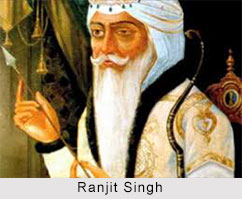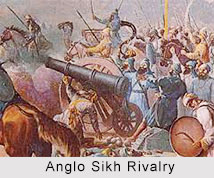 History of Princely State of Jammu and Kashmir came into existence after the downfall of Mughal Empire in India and later the death of Maharaja Ranjit Singh, one of the most prominent Sikh rulers in Western and Northern India.
History of Princely State of Jammu and Kashmir came into existence after the downfall of Mughal Empire in India and later the death of Maharaja Ranjit Singh, one of the most prominent Sikh rulers in Western and Northern India.
Anarchy Time in Jammu and Kashmir
After the death of Maharaja Ranjit Singh in 1839, the Sikh court fell into anarchy and palace intrigues took over. Gulab Singh`s brothers Dhyan Singh and Suchet Singh as well as his nephew Hira Singh were murdered in the struggles. His eldest son, Udham Singh, also died in the process. Gulab Singh was careful to disassociate himself from the intrigues and focused on managing his Jagir and expanding his influence in the territories surrounding Kashmir. Nevertheless, in early 1845, the Sikh Darbar marched on Jammu to seek the reputed treasures of Gulab Singh and demanded a fine of 30 million Nanakshahee rupees on the grounds that he had supported Hira Singh. But Gulab Singh used his battle skills as well as diplomacy to turn the Sikh troops in his favour and escaped with a payment of about 7 million rupees. He was however forced to surrender his second nephew Jawahir Singh, heir to Dhyan Singh, who was soon imprisoned by the Sikh Darbar.
First Anglo Sikh War and the Princely State of Jammu and Kashmir
The First Anglo-Sikh War began in 1845-1846. At that time, the relations between Gulab Singh and the Sikh Darbar were severely strained. Robert Huttenback states that Gulab Singh, as well as the British East India Company, had anticipated that the Sikh power would collapse after the death of Ranjit Singh and Gulab Singh positioned him to become an independent ruler in due course. He also maintained friendly relations with the British East India Company and had no intention of jeopardising them for the sake of the anarchic Sikh Darbar. On the other hand, Sikh army had no trust in any of the Sikh commanders in Lahore and asked for Gulab Singh to lead them. This, Gulab Singh refused to do. He counselled alliance with the British instead, and pursued his own communications with the British, seeking reassurance that his Jagirs would not be disturbed.
Formation of Princely State of Jammu and Kashmir
 Gulab Singh arrived in Lahore, during the Anglo Sikh War, and he was installed as the Prime Minister on 31st January 1846. He continued his criticism of the war and opened negotiations with the British. His conduct as the Prime Minister of the Sikh Government was duplicitous and contributed to a Sikh defeat. During the negotiations, the British East India Company in India were appreciative of Gulab Singh`s non-involvement in the war and offered to make him an independent ruler along with Kashmir Valley added to his domains. Thus, formed the Princely State of Jammu and Kashmir.
Gulab Singh arrived in Lahore, during the Anglo Sikh War, and he was installed as the Prime Minister on 31st January 1846. He continued his criticism of the war and opened negotiations with the British. His conduct as the Prime Minister of the Sikh Government was duplicitous and contributed to a Sikh defeat. During the negotiations, the British East India Company in India were appreciative of Gulab Singh`s non-involvement in the war and offered to make him an independent ruler along with Kashmir Valley added to his domains. Thus, formed the Princely State of Jammu and Kashmir.
After the Death of Gulab Singh
Gulab Singh died in 1857. His successor, Ranbir Singh, loyally sided with the British East India Company in the Indian Rebellion of 1857. When Kashmir had recovered from the strain of Revolt of 1857, Ranbir Singh determined to recover Gilgit and to expand the frontier. In 1860 a force under Devi Singh crossed the Indus, and advanced on Gaur Rahman`s fortress at Gilgit. Gaur Rahman had died just before the arrival of the Dogras, and Gilgit was taken. Gilgit was not the last frontier, however. Ranbir attempted to conquer Yasin and Punial, but failed for lack of funds. To make a secure frontier, he withdrew his forces to Gilgit. Kashmir and Jammu held Gilgit until the partition of India in 1947.
Related Articles
Modern History of India
British Empire in India
Princely States of India
Princely State of Jammu and Kashmir
Jammu and Kashmir
Culture of Jammu and Kashmir
Costumes of Jammu and Kashmir
Temples of Jammu and Kashmir
Kashmir



















